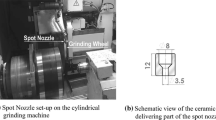Abstract
Grinding of low-carbon steel often exhibits severe wheel loading due to the formation of long chips and high adhering tendency of the work material with the grits. Conventional composite-type alumina wheels are commercially utilised for grinding low-carbon steel. However, the actual nature of grit wear cannot be truly understood in a composite wheel. The truing and dressing conditions also have some influences on the wear mechanism. Therefore, in order to explore the wear pattern on a single layer of grits, monolayer brazed cBN, white and grey Al2O3 wheels were used in the present study. The grindability of AISI 1020 steel was evaluated under dry, liquid nitrogen and neat oil environments. The surface profile of the workpiece after being ground in each environmental condition was traced with a surface profilometer to reveal the mechanism of grit wear. The post-grinding conditions of the wheels were observed using scanning electron microscopy. The cBN wheel was found to outperform the alumina wheels in terms of grinding forces and grit wear. The wear of the cBN wheel was remarkably arrested with the application of neat oil. On the other hand, large-scale adhesion and breakage of grits in white alumina wheel were observed under cryogenic environment. In fact, the beneficial role of liquid nitrogen could not be realised in reducing grinding forces and grit wear with all the three types of wheel. A lubricating agent like neat oil appeared to be more suitable than cryogenic cooling when grinding low-carbon steel.
Similar content being viewed by others
References
Hintermann HE, Chattopadhyay AK (1992) New generation superabrasive tool with monolayer configuration. Diamond Rel Mater 1:1131–1143. doi:10.1016/0925-9635(92)90087-5
Chattopadhyay AK, Chollet L, Hintermann HE (1991) On performance of brazed bonded monolayer diamond grinding wheel. CIRP Ann 40:347–350. doi:10.1016/S0007-8506(07)62003-4
Chattopadhyay AK, Hintermann HE (1994) On performance of brazed single-layer CBN wheel. CIRP Ann 43:313–317. doi:10.1016/S0007-8506(07)62221-5
Malkin S (1985) Current trends in CBN grinding technology. CIRP Ann 34:557–563. doi:10.1016/S0007-8506(07)60188-7
Zimmermann M, Lahres M, Viens DV, Laube BL (1997) Investigations of the wear of cubic boron nitride cutting tools using Auger electron spectroscopy and X-ray analysis by EPMA. Wear 209:241–246. doi:10.1016/S0043-1648(96)07488-1
Klimenko SA, Mukovoz YA, Lyashko VA, Vashchenko AN, Ogorodnik VV (1992) On the wear mechanism of cubic boron nitride base cutting tools. Wear 157:1–7. doi:10.1016/0043-1648(92)90183-9
Malkin S, Cook NH (1971) The wear of grinding wheels. Part 1. Attritious wear. J Eng Ind ASME Trans 93:1120–1128
Malkin S, Cook NH (1971) The wear of grinding wheels. Part 2. Fracture wear. J Eng Ind ASME Trans 93:1129–1133
Yossifon S, Rubenstein C (1981) The grinding of workpieces exhibiting high adhesion. Part 1: Mechanisms. J Eng Ind ASME Trans 103:144–155. doi:10.1115/1.3184469
Yossifon S, Rubenstein C (1981) The grinding of workpieces exhibiting high adhesion. Part 2: Forces. J Eng Ind ASME Trans 103:156–164. doi:10.1115/1.3184470
Yossifon S, Rubenstein C (1982) Wheel wear when grinding workpieces exhibiting high adhesion. Int J Mach Tool Des Res 22:159–176. doi:10.1016/0020-7357(82)90024-5
Hwang TW, Evans CJ, Whitenton EP, Malkin S (2000) High speed grinding of silicon nitride with electroplated diamond wheels. Part 1: Wear and wheel life. J Manuf Sci Eng ASME Trans 122:32–41. doi:10.1115/1.538908
Hwang TW, Evans CJ, Malkin S (2000) High speed grinding of silicon nitride with electroplated diamond wheels. Part 2: Wheel topography and grinding mechanisms. J Manuf Sci Eng ASME Trans 122:42–50. doi:10.1115/1.538909
Nguyen TD, Matsumaru K, Takatsu M, Ishizaki K (2009) Abrasive grain efficiency and surface roughness under wheel-loading on machining magnesium alloys. Azojomo J Mater Online 6:1–8. doi:10.2240/azojomo0290
Paul S, Chattopadhyay AB (1995) Effects of cryogenic cooling by liquid nitrogen jet on forces, temperature and surface residual stresses in grinding steels. Cryogenics 35:515–523. doi:10.1016/0011-2275(95)98219-Q
Chattopadhyay AB, Bose A, Chattopadhyay AK (1985) Improvements in grinding steels by cryogenic cooling. Pre Eng 7:93–98. doi:10.1016/0141-6359(85)90098-4
Paul S, Bandyopadhyay PP, Chattopadhyay AB (1993) Effects of cryo-cooling in grinding steels. J Mater Proc Technol 37:791–800. doi:10.1016/0924-0136(93)90137-U
Paul S, Chattopadhyay AB (1995) A study of effects of cryo-cooling in grinding. Int J Mach Tools Manuf 35:109–117. doi:10.1016/0890-6955(95)80010-7
Paul S, Chattopadhyay AB (1996) The effect of cryogenic cooling on grinding forces. Int J Mach Tools Manuf 36:63–72. doi:10.1016/0890-6955(95)92629-D
Fredj NB, Sidhom H, Braham C (2006) Ground surface improvement of the austenitic stainless steel AISI 304 using cryogenic cooling. Surf Coat Technol 200:4846–4860. doi:10.1016/j.surfcoat.2005.04.050
Nguyen T, Zarudi I, Zhang LC (2007) Grinding-hardening with liquid nitrogen: mechanisms and technology. Int J Mach Tools Manuf 47:97–106. doi:10.1016/j.ijmachtools.2006.02.010
Palhade RD, Tungikar VB, Dhole GM (2009) Application of different environments in grinding of titanium alloys (Ti-6Al-4V): investigations on precision brazed type monolayered cubic boron nitride (CBN) grinding wheel. IE (I) J-PR 90:8–13
Bhaduri D, Kumar R, Jain AK, Chattopadhyay AK (2010) On tribological behaviour and application of TiN and MoS2–Ti composite coating for enhancing performance of monolayer cBN grinding wheel. Wear 268:1053–1065. doi:10.1016/j.wear.2010.01.013
Fujimoto M, Ichida Y (2008) Micro fracture behavior of cutting edges in grinding using single crystal cBN grains. Diamond Rel Mater 17:1759–1763. doi:10.1016/j.diamond.2008.03.008
Breder K, Corbin N, Chinnakaruppan P, Hartline S (2005) The influence of grinding conditions on the performance of different CBN types. Ind Diamond Rev 4:32–36
Ding WF, Xu JH, Chen ZZ, Su HH, Fu YC (2010) Wear behavior and mechanism of single-layer brazed CBN abrasive wheels during creep-feed grinding cast nickel-based superalloy. Int J Adv Manuf Technol 51:541–550. doi:10.1007/s00170-010-2643-1
Howes T (1990) Assessment of the cooling and lubricative properties of grinding fluids. CIRP Ann 39:313–316. doi:10.1016/S0007-8506(07)61061-0
Author information
Authors and Affiliations
Corresponding author
Rights and permissions
About this article
Cite this article
Bhaduri, D., Kumar, R. & Chattopadhyay, A.K. On the grindability of low-carbon steel under dry, cryogenic and neat oil environments with monolayer brazed cBN and alumina wheels. Int J Adv Manuf Technol 57, 927–943 (2011). https://doi.org/10.1007/s00170-011-3341-3
Received:
Accepted:
Published:
Issue Date:
DOI: https://doi.org/10.1007/s00170-011-3341-3



